NUT714 Assignment 2: Stevia Safety Assessment and Toxicology Report
VerifiedAdded on 2023/04/12
|11
|1908
|273
Report
AI Summary
This report provides a comprehensive safety assessment of stevia, a non-nutritive sweetener derived from the Stevia rebaudiana plant. It examines the history of stevia use, its technical data and product specifications, biological and toxicological data, and objections to its safety. The report highlights the controversies surrounding stevia's acceptance due to limited human trials and conflicting evidence regarding its safety. It discusses the role of organizations like the FDA, EFSA, and JECFA in regulating stevia's use, emphasizing the importance of further research to fully establish stevia's efficacy and ensure its safe consumption as a sugar alternative. The report concludes that while stevia holds promise as a solution to rising metabolic disorders, more research is needed to address existing concerns.
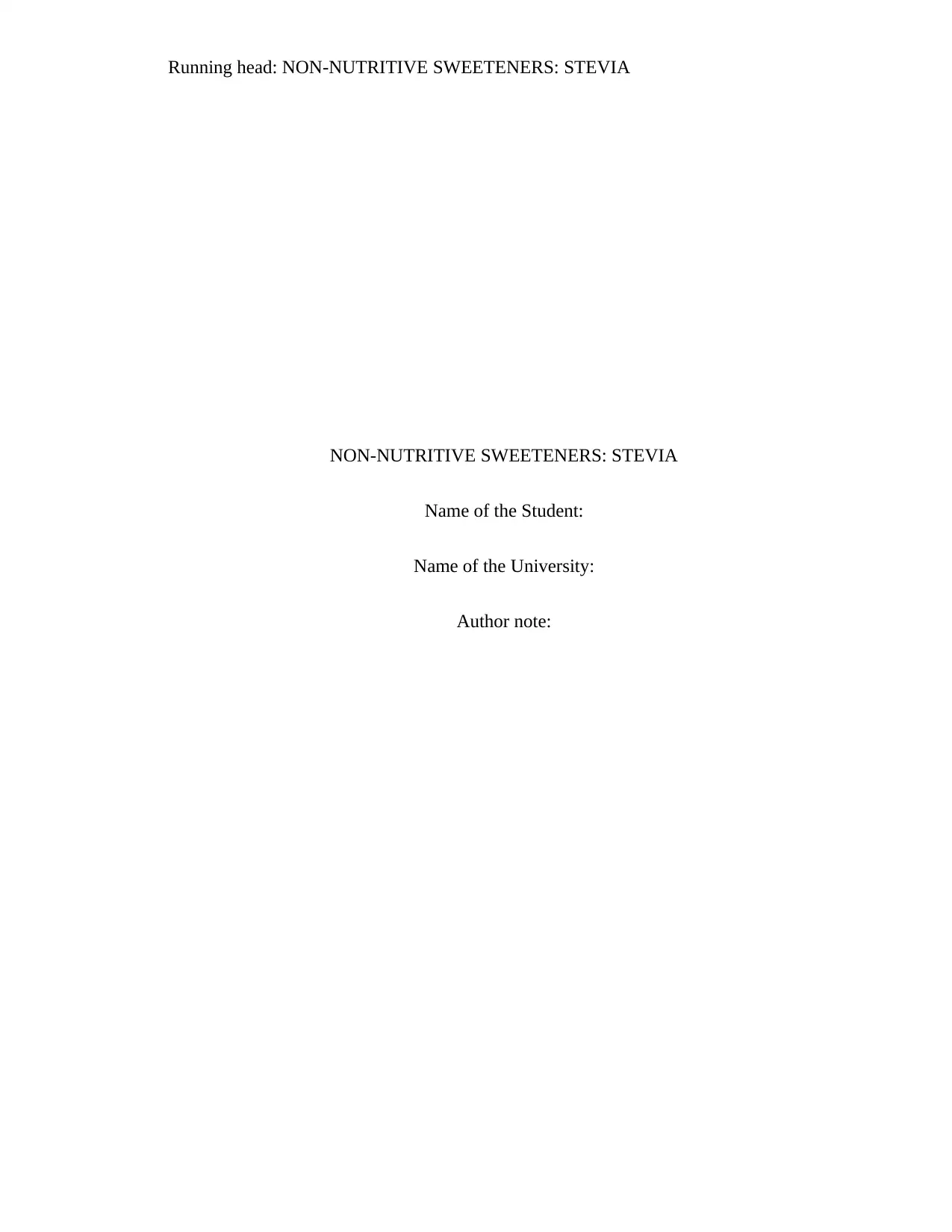
Running head: NON-NUTRITIVE SWEETENERS: STEVIA
NON-NUTRITIVE SWEETENERS: STEVIA
Name of the Student:
Name of the University:
Author note:
NON-NUTRITIVE SWEETENERS: STEVIA
Name of the Student:
Name of the University:
Author note:
Paraphrase This Document
Need a fresh take? Get an instant paraphrase of this document with our AI Paraphraser
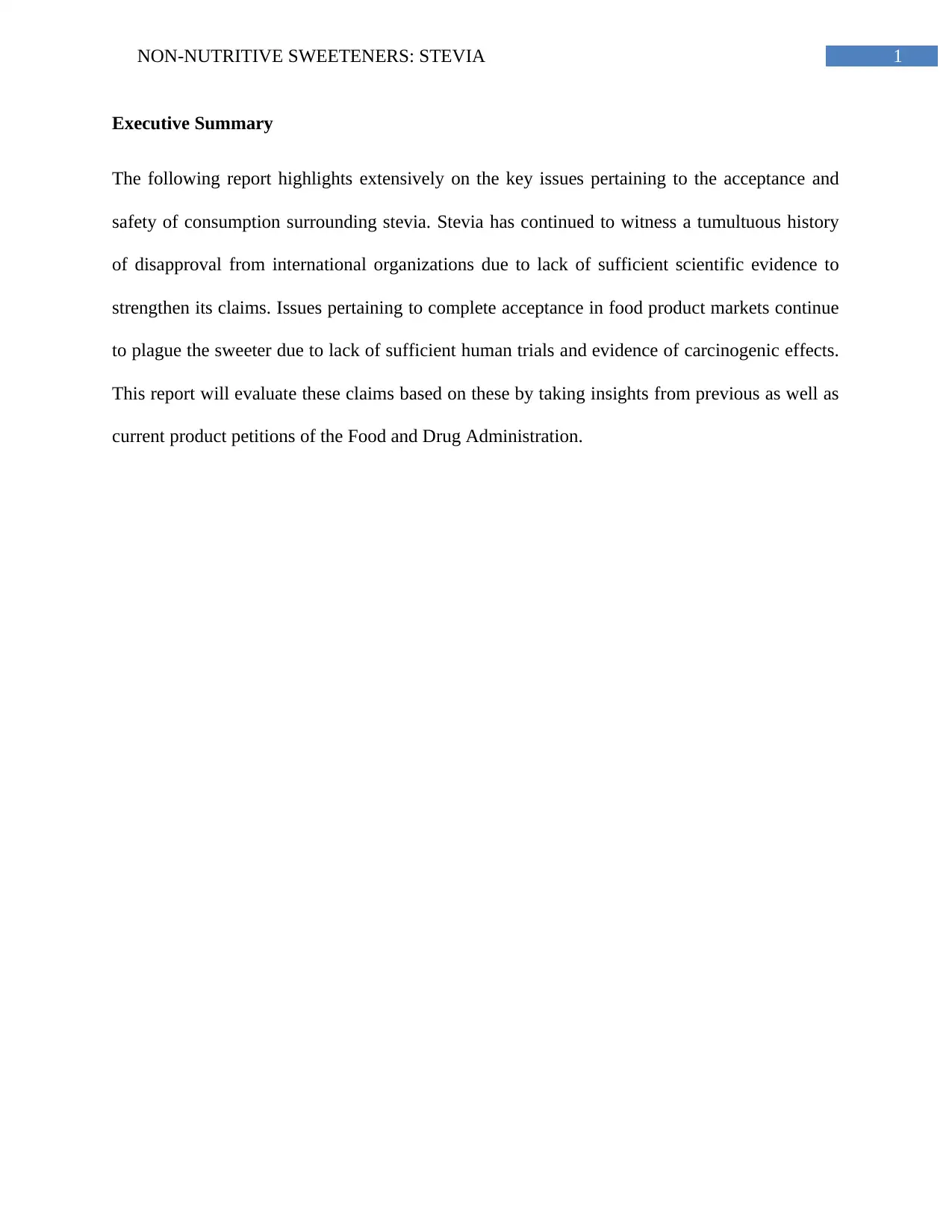
1NON-NUTRITIVE SWEETENERS: STEVIA
Executive Summary
The following report highlights extensively on the key issues pertaining to the acceptance and
safety of consumption surrounding stevia. Stevia has continued to witness a tumultuous history
of disapproval from international organizations due to lack of sufficient scientific evidence to
strengthen its claims. Issues pertaining to complete acceptance in food product markets continue
to plague the sweeter due to lack of sufficient human trials and evidence of carcinogenic effects.
This report will evaluate these claims based on these by taking insights from previous as well as
current product petitions of the Food and Drug Administration.
Executive Summary
The following report highlights extensively on the key issues pertaining to the acceptance and
safety of consumption surrounding stevia. Stevia has continued to witness a tumultuous history
of disapproval from international organizations due to lack of sufficient scientific evidence to
strengthen its claims. Issues pertaining to complete acceptance in food product markets continue
to plague the sweeter due to lack of sufficient human trials and evidence of carcinogenic effects.
This report will evaluate these claims based on these by taking insights from previous as well as
current product petitions of the Food and Drug Administration.
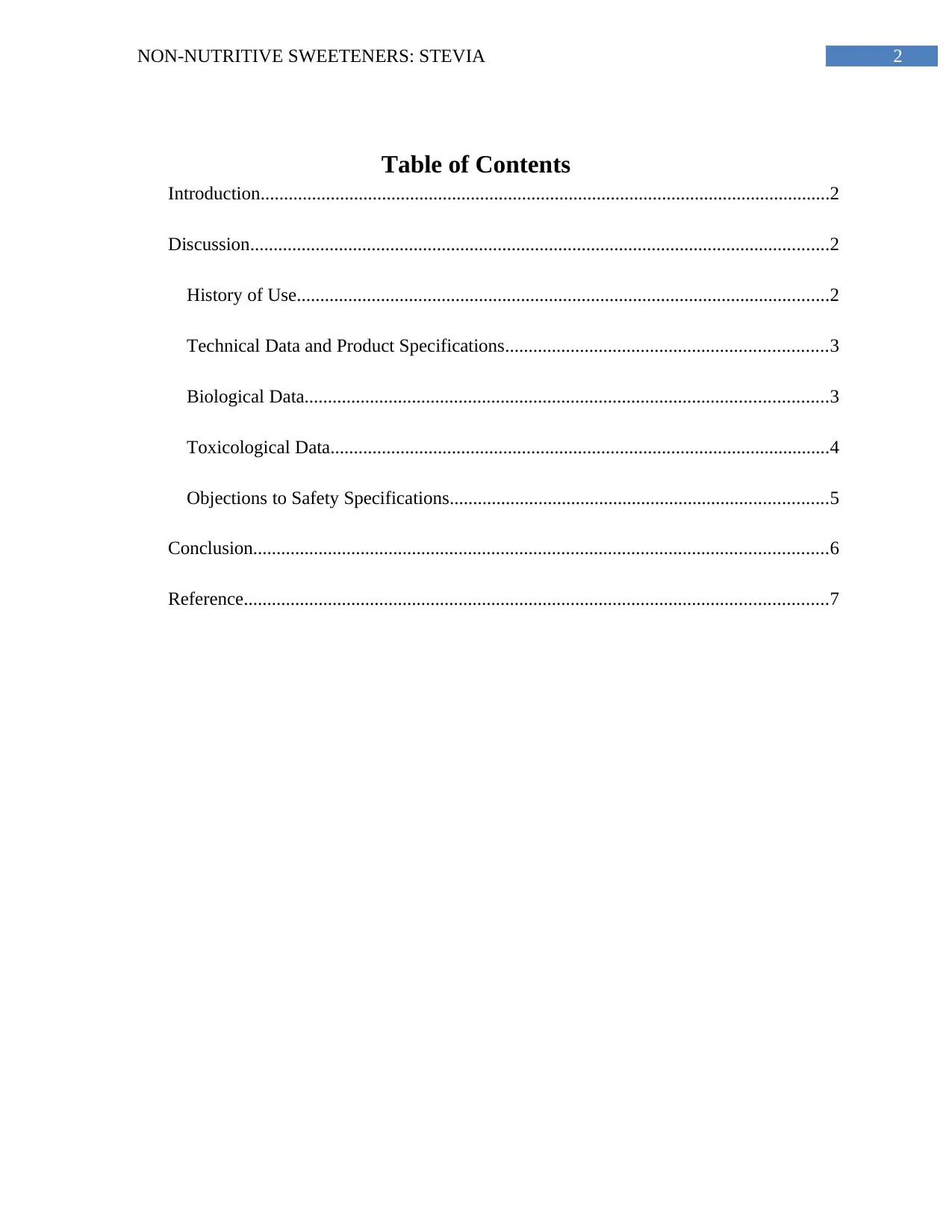
2NON-NUTRITIVE SWEETENERS: STEVIA
Table of Contents
Introduction..........................................................................................................................2
Discussion............................................................................................................................2
History of Use..................................................................................................................2
Technical Data and Product Specifications.....................................................................3
Biological Data................................................................................................................3
Toxicological Data...........................................................................................................4
Objections to Safety Specifications.................................................................................5
Conclusion...........................................................................................................................6
Reference.............................................................................................................................7
Table of Contents
Introduction..........................................................................................................................2
Discussion............................................................................................................................2
History of Use..................................................................................................................2
Technical Data and Product Specifications.....................................................................3
Biological Data................................................................................................................3
Toxicological Data...........................................................................................................4
Objections to Safety Specifications.................................................................................5
Conclusion...........................................................................................................................6
Reference.............................................................................................................................7
⊘ This is a preview!⊘
Do you want full access?
Subscribe today to unlock all pages.

Trusted by 1+ million students worldwide
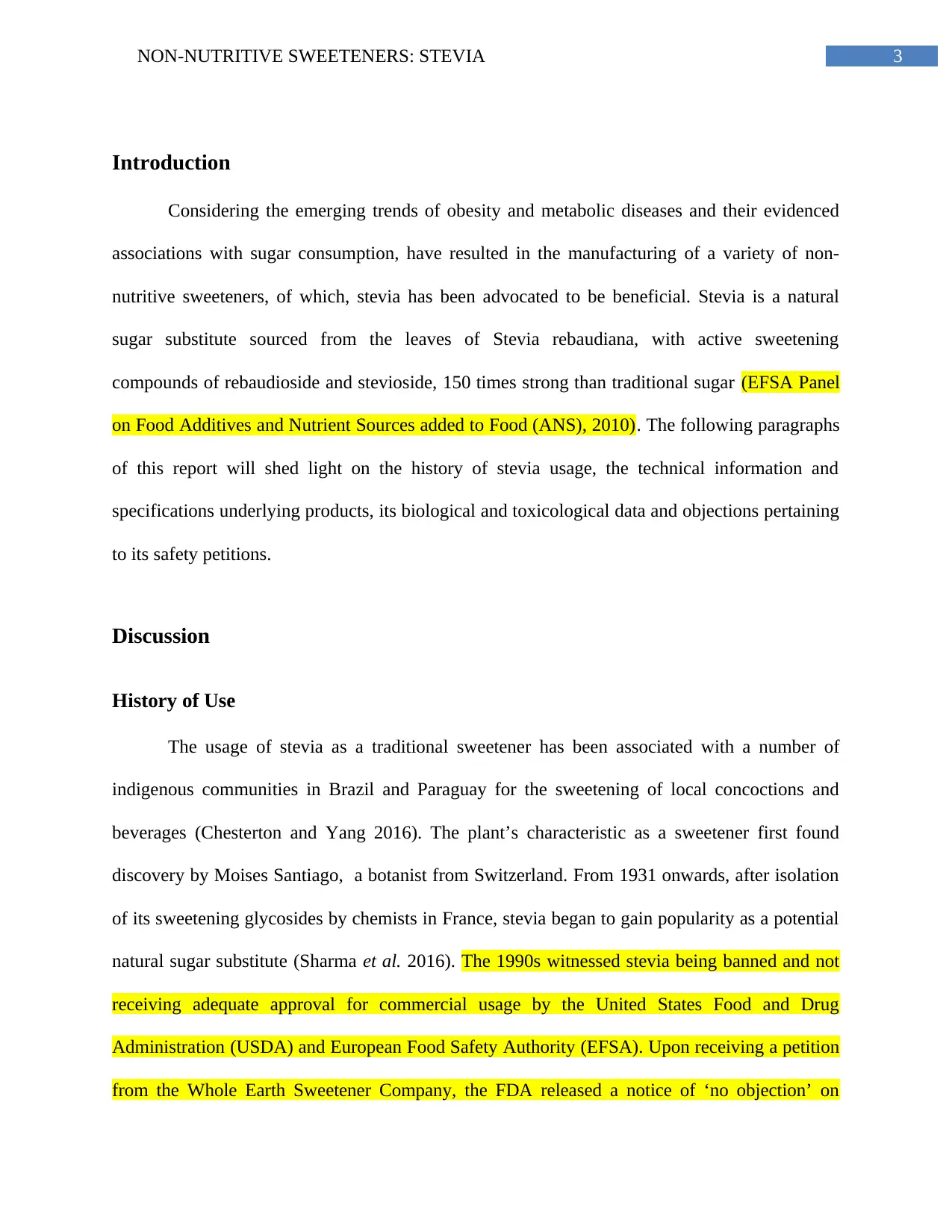
3NON-NUTRITIVE SWEETENERS: STEVIA
Introduction
Considering the emerging trends of obesity and metabolic diseases and their evidenced
associations with sugar consumption, have resulted in the manufacturing of a variety of non-
nutritive sweeteners, of which, stevia has been advocated to be beneficial. Stevia is a natural
sugar substitute sourced from the leaves of Stevia rebaudiana, with active sweetening
compounds of rebaudioside and stevioside, 150 times strong than traditional sugar (EFSA Panel
on Food Additives and Nutrient Sources added to Food (ANS), 2010). The following paragraphs
of this report will shed light on the history of stevia usage, the technical information and
specifications underlying products, its biological and toxicological data and objections pertaining
to its safety petitions.
Discussion
History of Use
The usage of stevia as a traditional sweetener has been associated with a number of
indigenous communities in Brazil and Paraguay for the sweetening of local concoctions and
beverages (Chesterton and Yang 2016). The plant’s characteristic as a sweetener first found
discovery by Moises Santiago, a botanist from Switzerland. From 1931 onwards, after isolation
of its sweetening glycosides by chemists in France, stevia began to gain popularity as a potential
natural sugar substitute (Sharma et al. 2016). The 1990s witnessed stevia being banned and not
receiving adequate approval for commercial usage by the United States Food and Drug
Administration (USDA) and European Food Safety Authority (EFSA). Upon receiving a petition
from the Whole Earth Sweetener Company, the FDA released a notice of ‘no objection’ on
Introduction
Considering the emerging trends of obesity and metabolic diseases and their evidenced
associations with sugar consumption, have resulted in the manufacturing of a variety of non-
nutritive sweeteners, of which, stevia has been advocated to be beneficial. Stevia is a natural
sugar substitute sourced from the leaves of Stevia rebaudiana, with active sweetening
compounds of rebaudioside and stevioside, 150 times strong than traditional sugar (EFSA Panel
on Food Additives and Nutrient Sources added to Food (ANS), 2010). The following paragraphs
of this report will shed light on the history of stevia usage, the technical information and
specifications underlying products, its biological and toxicological data and objections pertaining
to its safety petitions.
Discussion
History of Use
The usage of stevia as a traditional sweetener has been associated with a number of
indigenous communities in Brazil and Paraguay for the sweetening of local concoctions and
beverages (Chesterton and Yang 2016). The plant’s characteristic as a sweetener first found
discovery by Moises Santiago, a botanist from Switzerland. From 1931 onwards, after isolation
of its sweetening glycosides by chemists in France, stevia began to gain popularity as a potential
natural sugar substitute (Sharma et al. 2016). The 1990s witnessed stevia being banned and not
receiving adequate approval for commercial usage by the United States Food and Drug
Administration (USDA) and European Food Safety Authority (EFSA). Upon receiving a petition
from the Whole Earth Sweetener Company, the FDA released a notice of ‘no objection’ on
Paraphrase This Document
Need a fresh take? Get an instant paraphrase of this document with our AI Paraphraser
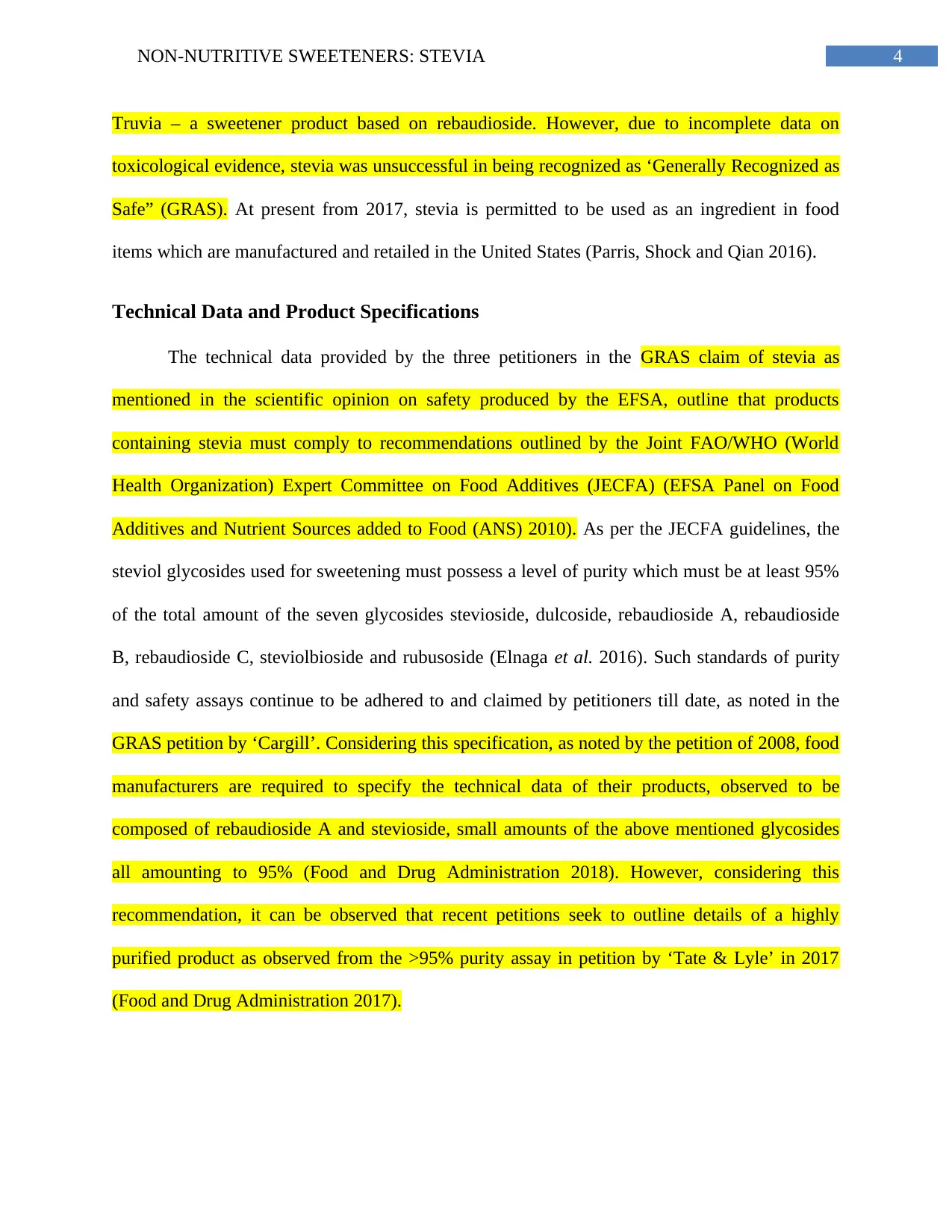
4NON-NUTRITIVE SWEETENERS: STEVIA
Truvia – a sweetener product based on rebaudioside. However, due to incomplete data on
toxicological evidence, stevia was unsuccessful in being recognized as ‘Generally Recognized as
Safe” (GRAS). At present from 2017, stevia is permitted to be used as an ingredient in food
items which are manufactured and retailed in the United States (Parris, Shock and Qian 2016).
Technical Data and Product Specifications
The technical data provided by the three petitioners in the GRAS claim of stevia as
mentioned in the scientific opinion on safety produced by the EFSA, outline that products
containing stevia must comply to recommendations outlined by the Joint FAO/WHO (World
Health Organization) Expert Committee on Food Additives (JECFA) (EFSA Panel on Food
Additives and Nutrient Sources added to Food (ANS) 2010). As per the JECFA guidelines, the
steviol glycosides used for sweetening must possess a level of purity which must be at least 95%
of the total amount of the seven glycosides stevioside, dulcoside, rebaudioside A, rebaudioside
B, rebaudioside C, steviolbioside and rubusoside (Elnaga et al. 2016). Such standards of purity
and safety assays continue to be adhered to and claimed by petitioners till date, as noted in the
GRAS petition by ‘Cargill’. Considering this specification, as noted by the petition of 2008, food
manufacturers are required to specify the technical data of their products, observed to be
composed of rebaudioside A and stevioside, small amounts of the above mentioned glycosides
all amounting to 95% (Food and Drug Administration 2018). However, considering this
recommendation, it can be observed that recent petitions seek to outline details of a highly
purified product as observed from the >95% purity assay in petition by ‘Tate & Lyle’ in 2017
(Food and Drug Administration 2017).
Truvia – a sweetener product based on rebaudioside. However, due to incomplete data on
toxicological evidence, stevia was unsuccessful in being recognized as ‘Generally Recognized as
Safe” (GRAS). At present from 2017, stevia is permitted to be used as an ingredient in food
items which are manufactured and retailed in the United States (Parris, Shock and Qian 2016).
Technical Data and Product Specifications
The technical data provided by the three petitioners in the GRAS claim of stevia as
mentioned in the scientific opinion on safety produced by the EFSA, outline that products
containing stevia must comply to recommendations outlined by the Joint FAO/WHO (World
Health Organization) Expert Committee on Food Additives (JECFA) (EFSA Panel on Food
Additives and Nutrient Sources added to Food (ANS) 2010). As per the JECFA guidelines, the
steviol glycosides used for sweetening must possess a level of purity which must be at least 95%
of the total amount of the seven glycosides stevioside, dulcoside, rebaudioside A, rebaudioside
B, rebaudioside C, steviolbioside and rubusoside (Elnaga et al. 2016). Such standards of purity
and safety assays continue to be adhered to and claimed by petitioners till date, as noted in the
GRAS petition by ‘Cargill’. Considering this specification, as noted by the petition of 2008, food
manufacturers are required to specify the technical data of their products, observed to be
composed of rebaudioside A and stevioside, small amounts of the above mentioned glycosides
all amounting to 95% (Food and Drug Administration 2018). However, considering this
recommendation, it can be observed that recent petitions seek to outline details of a highly
purified product as observed from the >95% purity assay in petition by ‘Tate & Lyle’ in 2017
(Food and Drug Administration 2017).
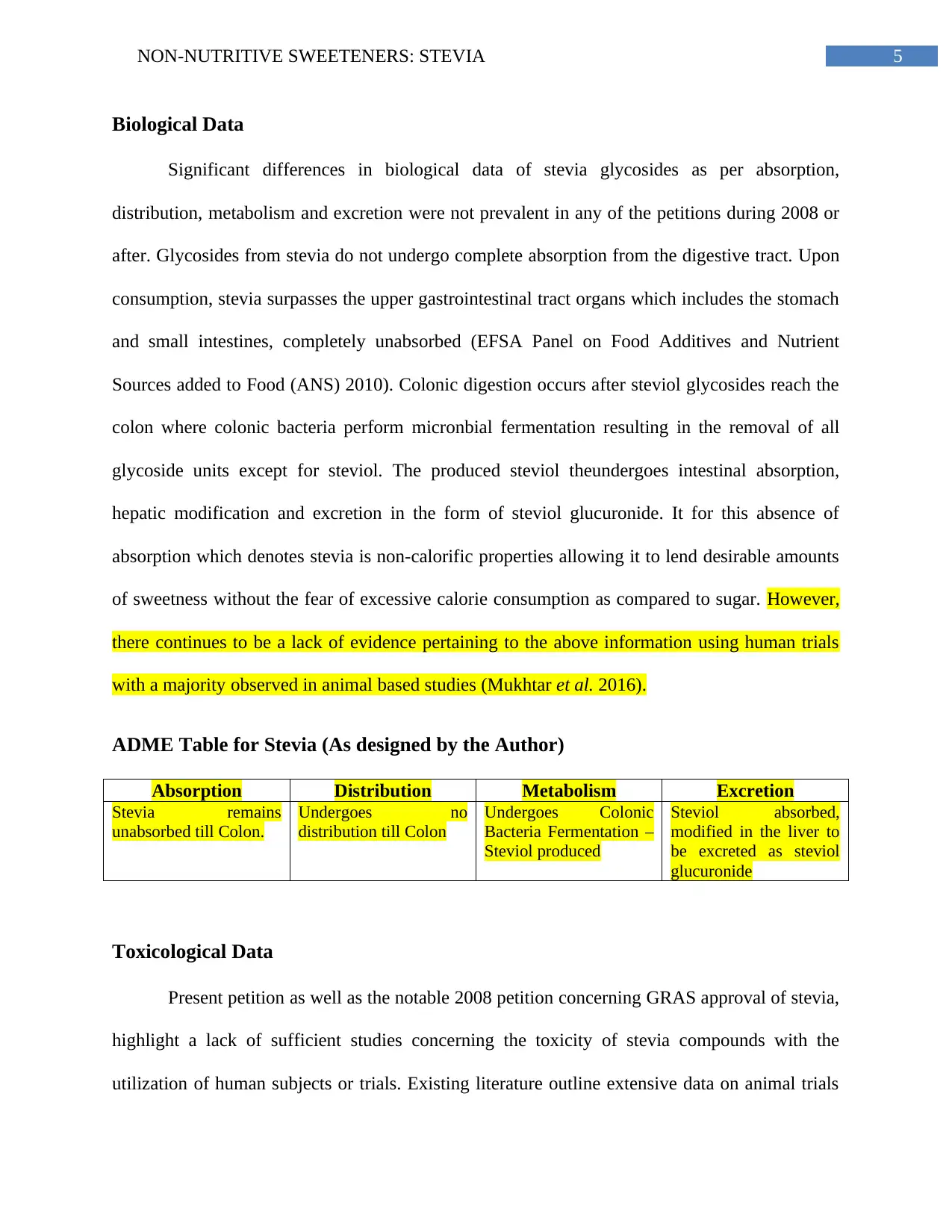
5NON-NUTRITIVE SWEETENERS: STEVIA
Biological Data
Significant differences in biological data of stevia glycosides as per absorption,
distribution, metabolism and excretion were not prevalent in any of the petitions during 2008 or
after. Glycosides from stevia do not undergo complete absorption from the digestive tract. Upon
consumption, stevia surpasses the upper gastrointestinal tract organs which includes the stomach
and small intestines, completely unabsorbed (EFSA Panel on Food Additives and Nutrient
Sources added to Food (ANS) 2010). Colonic digestion occurs after steviol glycosides reach the
colon where colonic bacteria perform micronbial fermentation resulting in the removal of all
glycoside units except for steviol. The produced steviol theundergoes intestinal absorption,
hepatic modification and excretion in the form of steviol glucuronide. It for this absence of
absorption which denotes stevia is non-calorific properties allowing it to lend desirable amounts
of sweetness without the fear of excessive calorie consumption as compared to sugar. However,
there continues to be a lack of evidence pertaining to the above information using human trials
with a majority observed in animal based studies (Mukhtar et al. 2016).
ADME Table for Stevia (As designed by the Author)
Absorption Distribution Metabolism Excretion
Stevia remains
unabsorbed till Colon.
Undergoes no
distribution till Colon
Undergoes Colonic
Bacteria Fermentation –
Steviol produced
Steviol absorbed,
modified in the liver to
be excreted as steviol
glucuronide
Toxicological Data
Present petition as well as the notable 2008 petition concerning GRAS approval of stevia,
highlight a lack of sufficient studies concerning the toxicity of stevia compounds with the
utilization of human subjects or trials. Existing literature outline extensive data on animal trials
Biological Data
Significant differences in biological data of stevia glycosides as per absorption,
distribution, metabolism and excretion were not prevalent in any of the petitions during 2008 or
after. Glycosides from stevia do not undergo complete absorption from the digestive tract. Upon
consumption, stevia surpasses the upper gastrointestinal tract organs which includes the stomach
and small intestines, completely unabsorbed (EFSA Panel on Food Additives and Nutrient
Sources added to Food (ANS) 2010). Colonic digestion occurs after steviol glycosides reach the
colon where colonic bacteria perform micronbial fermentation resulting in the removal of all
glycoside units except for steviol. The produced steviol theundergoes intestinal absorption,
hepatic modification and excretion in the form of steviol glucuronide. It for this absence of
absorption which denotes stevia is non-calorific properties allowing it to lend desirable amounts
of sweetness without the fear of excessive calorie consumption as compared to sugar. However,
there continues to be a lack of evidence pertaining to the above information using human trials
with a majority observed in animal based studies (Mukhtar et al. 2016).
ADME Table for Stevia (As designed by the Author)
Absorption Distribution Metabolism Excretion
Stevia remains
unabsorbed till Colon.
Undergoes no
distribution till Colon
Undergoes Colonic
Bacteria Fermentation –
Steviol produced
Steviol absorbed,
modified in the liver to
be excreted as steviol
glucuronide
Toxicological Data
Present petition as well as the notable 2008 petition concerning GRAS approval of stevia,
highlight a lack of sufficient studies concerning the toxicity of stevia compounds with the
utilization of human subjects or trials. Existing literature outline extensive data on animal trials
⊘ This is a preview!⊘
Do you want full access?
Subscribe today to unlock all pages.

Trusted by 1+ million students worldwide
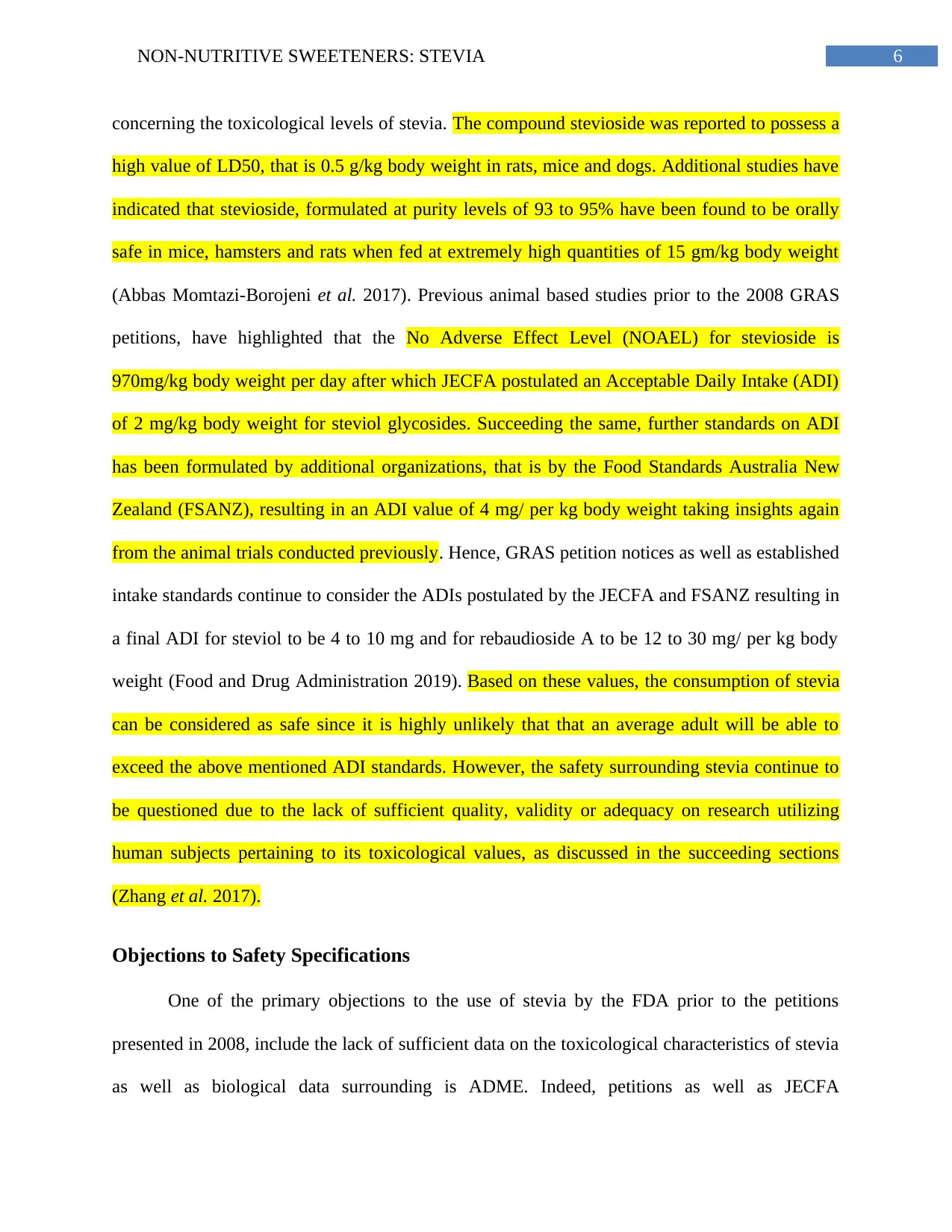
6NON-NUTRITIVE SWEETENERS: STEVIA
concerning the toxicological levels of stevia. The compound stevioside was reported to possess a
high value of LD50, that is 0.5 g/kg body weight in rats, mice and dogs. Additional studies have
indicated that stevioside, formulated at purity levels of 93 to 95% have been found to be orally
safe in mice, hamsters and rats when fed at extremely high quantities of 15 gm/kg body weight
(Abbas Momtazi-Borojeni et al. 2017). Previous animal based studies prior to the 2008 GRAS
petitions, have highlighted that the No Adverse Effect Level (NOAEL) for stevioside is
970mg/kg body weight per day after which JECFA postulated an Acceptable Daily Intake (ADI)
of 2 mg/kg body weight for steviol glycosides. Succeeding the same, further standards on ADI
has been formulated by additional organizations, that is by the Food Standards Australia New
Zealand (FSANZ), resulting in an ADI value of 4 mg/ per kg body weight taking insights again
from the animal trials conducted previously. Hence, GRAS petition notices as well as established
intake standards continue to consider the ADIs postulated by the JECFA and FSANZ resulting in
a final ADI for steviol to be 4 to 10 mg and for rebaudioside A to be 12 to 30 mg/ per kg body
weight (Food and Drug Administration 2019). Based on these values, the consumption of stevia
can be considered as safe since it is highly unlikely that that an average adult will be able to
exceed the above mentioned ADI standards. However, the safety surrounding stevia continue to
be questioned due to the lack of sufficient quality, validity or adequacy on research utilizing
human subjects pertaining to its toxicological values, as discussed in the succeeding sections
(Zhang et al. 2017).
Objections to Safety Specifications
One of the primary objections to the use of stevia by the FDA prior to the petitions
presented in 2008, include the lack of sufficient data on the toxicological characteristics of stevia
as well as biological data surrounding is ADME. Indeed, petitions as well as JECFA
concerning the toxicological levels of stevia. The compound stevioside was reported to possess a
high value of LD50, that is 0.5 g/kg body weight in rats, mice and dogs. Additional studies have
indicated that stevioside, formulated at purity levels of 93 to 95% have been found to be orally
safe in mice, hamsters and rats when fed at extremely high quantities of 15 gm/kg body weight
(Abbas Momtazi-Borojeni et al. 2017). Previous animal based studies prior to the 2008 GRAS
petitions, have highlighted that the No Adverse Effect Level (NOAEL) for stevioside is
970mg/kg body weight per day after which JECFA postulated an Acceptable Daily Intake (ADI)
of 2 mg/kg body weight for steviol glycosides. Succeeding the same, further standards on ADI
has been formulated by additional organizations, that is by the Food Standards Australia New
Zealand (FSANZ), resulting in an ADI value of 4 mg/ per kg body weight taking insights again
from the animal trials conducted previously. Hence, GRAS petition notices as well as established
intake standards continue to consider the ADIs postulated by the JECFA and FSANZ resulting in
a final ADI for steviol to be 4 to 10 mg and for rebaudioside A to be 12 to 30 mg/ per kg body
weight (Food and Drug Administration 2019). Based on these values, the consumption of stevia
can be considered as safe since it is highly unlikely that that an average adult will be able to
exceed the above mentioned ADI standards. However, the safety surrounding stevia continue to
be questioned due to the lack of sufficient quality, validity or adequacy on research utilizing
human subjects pertaining to its toxicological values, as discussed in the succeeding sections
(Zhang et al. 2017).
Objections to Safety Specifications
One of the primary objections to the use of stevia by the FDA prior to the petitions
presented in 2008, include the lack of sufficient data on the toxicological characteristics of stevia
as well as biological data surrounding is ADME. Indeed, petitions as well as JECFA
Paraphrase This Document
Need a fresh take? Get an instant paraphrase of this document with our AI Paraphraser
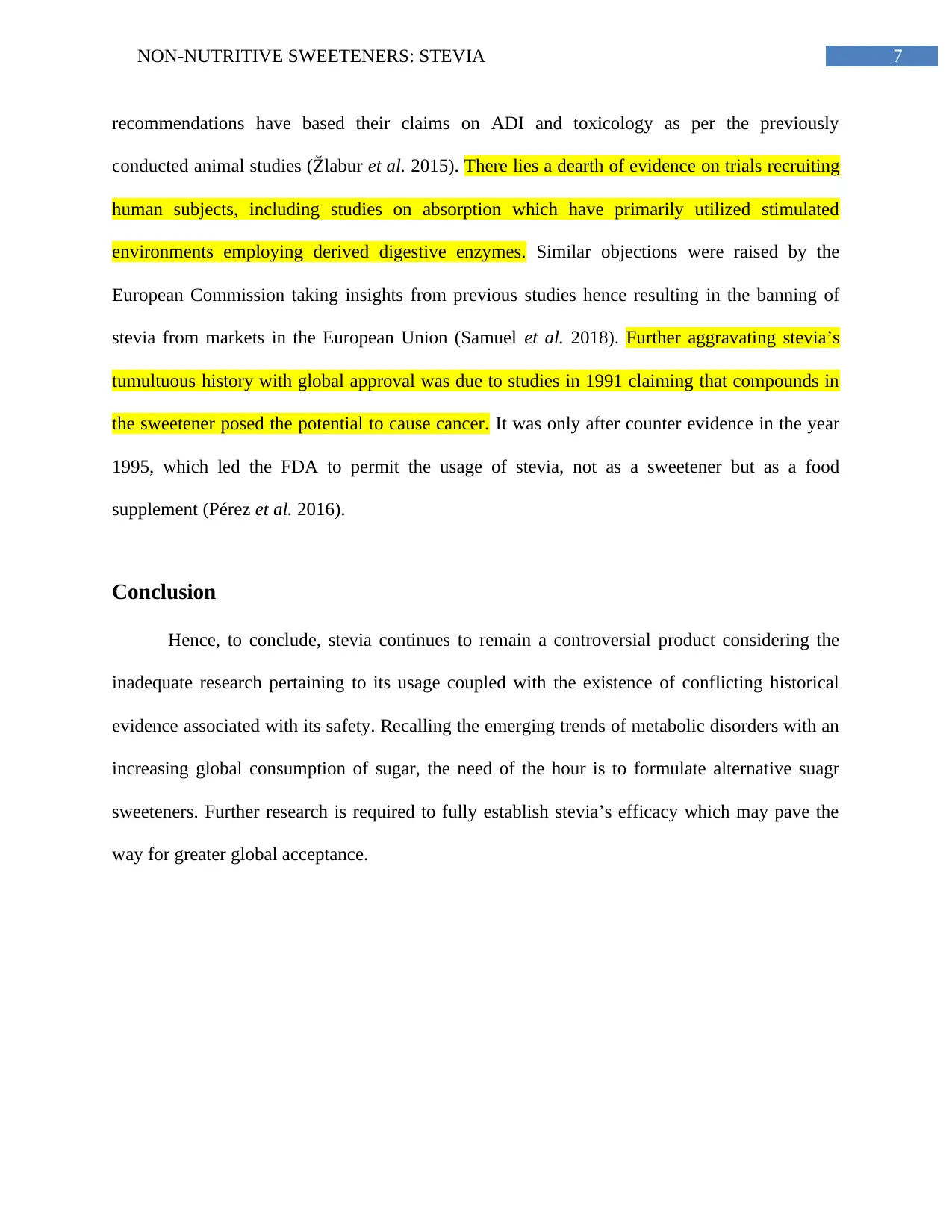
7NON-NUTRITIVE SWEETENERS: STEVIA
recommendations have based their claims on ADI and toxicology as per the previously
conducted animal studies (Žlabur et al. 2015). There lies a dearth of evidence on trials recruiting
human subjects, including studies on absorption which have primarily utilized stimulated
environments employing derived digestive enzymes. Similar objections were raised by the
European Commission taking insights from previous studies hence resulting in the banning of
stevia from markets in the European Union (Samuel et al. 2018). Further aggravating stevia’s
tumultuous history with global approval was due to studies in 1991 claiming that compounds in
the sweetener posed the potential to cause cancer. It was only after counter evidence in the year
1995, which led the FDA to permit the usage of stevia, not as a sweetener but as a food
supplement (Pérez et al. 2016).
Conclusion
Hence, to conclude, stevia continues to remain a controversial product considering the
inadequate research pertaining to its usage coupled with the existence of conflicting historical
evidence associated with its safety. Recalling the emerging trends of metabolic disorders with an
increasing global consumption of sugar, the need of the hour is to formulate alternative suagr
sweeteners. Further research is required to fully establish stevia’s efficacy which may pave the
way for greater global acceptance.
recommendations have based their claims on ADI and toxicology as per the previously
conducted animal studies (Žlabur et al. 2015). There lies a dearth of evidence on trials recruiting
human subjects, including studies on absorption which have primarily utilized stimulated
environments employing derived digestive enzymes. Similar objections were raised by the
European Commission taking insights from previous studies hence resulting in the banning of
stevia from markets in the European Union (Samuel et al. 2018). Further aggravating stevia’s
tumultuous history with global approval was due to studies in 1991 claiming that compounds in
the sweetener posed the potential to cause cancer. It was only after counter evidence in the year
1995, which led the FDA to permit the usage of stevia, not as a sweetener but as a food
supplement (Pérez et al. 2016).
Conclusion
Hence, to conclude, stevia continues to remain a controversial product considering the
inadequate research pertaining to its usage coupled with the existence of conflicting historical
evidence associated with its safety. Recalling the emerging trends of metabolic disorders with an
increasing global consumption of sugar, the need of the hour is to formulate alternative suagr
sweeteners. Further research is required to fully establish stevia’s efficacy which may pave the
way for greater global acceptance.
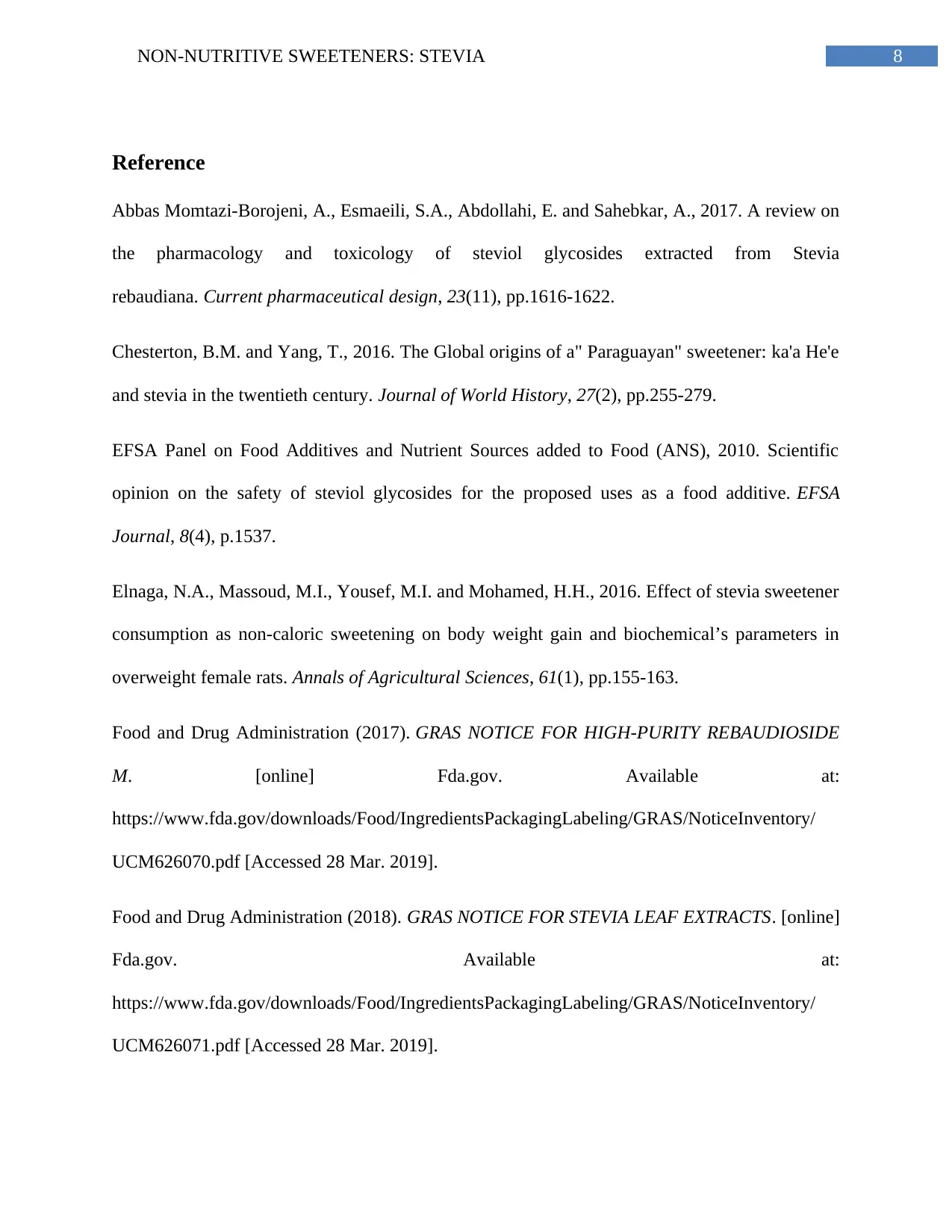
8NON-NUTRITIVE SWEETENERS: STEVIA
Reference
Abbas Momtazi-Borojeni, A., Esmaeili, S.A., Abdollahi, E. and Sahebkar, A., 2017. A review on
the pharmacology and toxicology of steviol glycosides extracted from Stevia
rebaudiana. Current pharmaceutical design, 23(11), pp.1616-1622.
Chesterton, B.M. and Yang, T., 2016. The Global origins of a" Paraguayan" sweetener: ka'a He'e
and stevia in the twentieth century. Journal of World History, 27(2), pp.255-279.
EFSA Panel on Food Additives and Nutrient Sources added to Food (ANS), 2010. Scientific
opinion on the safety of steviol glycosides for the proposed uses as a food additive. EFSA
Journal, 8(4), p.1537.
Elnaga, N.A., Massoud, M.I., Yousef, M.I. and Mohamed, H.H., 2016. Effect of stevia sweetener
consumption as non-caloric sweetening on body weight gain and biochemical’s parameters in
overweight female rats. Annals of Agricultural Sciences, 61(1), pp.155-163.
Food and Drug Administration (2017). GRAS NOTICE FOR HIGH-PURITY REBAUDIOSIDE
M. [online] Fda.gov. Available at:
https://www.fda.gov/downloads/Food/IngredientsPackagingLabeling/GRAS/NoticeInventory/
UCM626070.pdf [Accessed 28 Mar. 2019].
Food and Drug Administration (2018). GRAS NOTICE FOR STEVIA LEAF EXTRACTS. [online]
Fda.gov. Available at:
https://www.fda.gov/downloads/Food/IngredientsPackagingLabeling/GRAS/NoticeInventory/
UCM626071.pdf [Accessed 28 Mar. 2019].
Reference
Abbas Momtazi-Borojeni, A., Esmaeili, S.A., Abdollahi, E. and Sahebkar, A., 2017. A review on
the pharmacology and toxicology of steviol glycosides extracted from Stevia
rebaudiana. Current pharmaceutical design, 23(11), pp.1616-1622.
Chesterton, B.M. and Yang, T., 2016. The Global origins of a" Paraguayan" sweetener: ka'a He'e
and stevia in the twentieth century. Journal of World History, 27(2), pp.255-279.
EFSA Panel on Food Additives and Nutrient Sources added to Food (ANS), 2010. Scientific
opinion on the safety of steviol glycosides for the proposed uses as a food additive. EFSA
Journal, 8(4), p.1537.
Elnaga, N.A., Massoud, M.I., Yousef, M.I. and Mohamed, H.H., 2016. Effect of stevia sweetener
consumption as non-caloric sweetening on body weight gain and biochemical’s parameters in
overweight female rats. Annals of Agricultural Sciences, 61(1), pp.155-163.
Food and Drug Administration (2017). GRAS NOTICE FOR HIGH-PURITY REBAUDIOSIDE
M. [online] Fda.gov. Available at:
https://www.fda.gov/downloads/Food/IngredientsPackagingLabeling/GRAS/NoticeInventory/
UCM626070.pdf [Accessed 28 Mar. 2019].
Food and Drug Administration (2018). GRAS NOTICE FOR STEVIA LEAF EXTRACTS. [online]
Fda.gov. Available at:
https://www.fda.gov/downloads/Food/IngredientsPackagingLabeling/GRAS/NoticeInventory/
UCM626071.pdf [Accessed 28 Mar. 2019].
⊘ This is a preview!⊘
Do you want full access?
Subscribe today to unlock all pages.

Trusted by 1+ million students worldwide
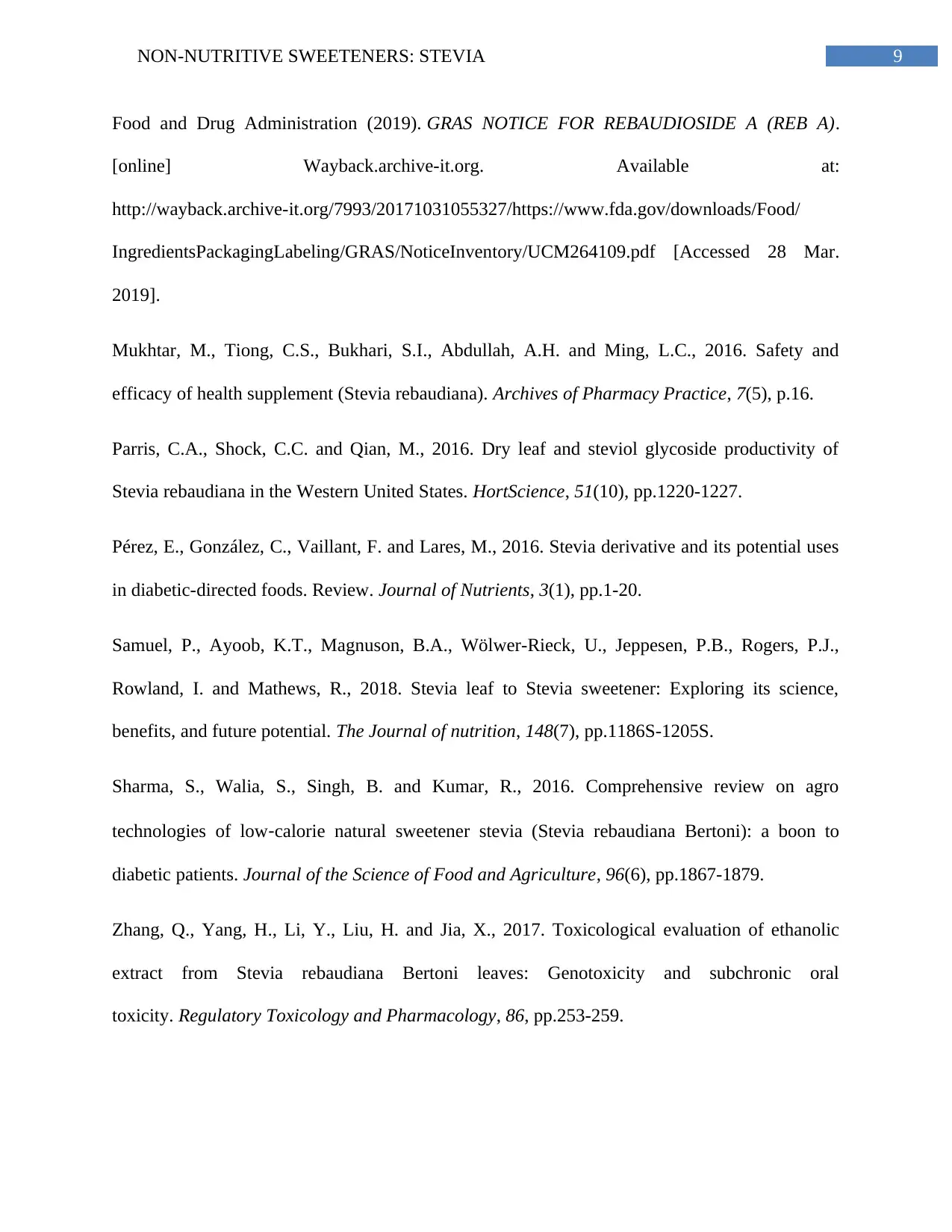
9NON-NUTRITIVE SWEETENERS: STEVIA
Food and Drug Administration (2019). GRAS NOTICE FOR REBAUDIOSIDE A (REB A).
[online] Wayback.archive-it.org. Available at:
http://wayback.archive-it.org/7993/20171031055327/https://www.fda.gov/downloads/Food/
IngredientsPackagingLabeling/GRAS/NoticeInventory/UCM264109.pdf [Accessed 28 Mar.
2019].
Mukhtar, M., Tiong, C.S., Bukhari, S.I., Abdullah, A.H. and Ming, L.C., 2016. Safety and
efficacy of health supplement (Stevia rebaudiana). Archives of Pharmacy Practice, 7(5), p.16.
Parris, C.A., Shock, C.C. and Qian, M., 2016. Dry leaf and steviol glycoside productivity of
Stevia rebaudiana in the Western United States. HortScience, 51(10), pp.1220-1227.
Pérez, E., González, C., Vaillant, F. and Lares, M., 2016. Stevia derivative and its potential uses
in diabetic-directed foods. Review. Journal of Nutrients, 3(1), pp.1-20.
Samuel, P., Ayoob, K.T., Magnuson, B.A., Wölwer-Rieck, U., Jeppesen, P.B., Rogers, P.J.,
Rowland, I. and Mathews, R., 2018. Stevia leaf to Stevia sweetener: Exploring its science,
benefits, and future potential. The Journal of nutrition, 148(7), pp.1186S-1205S.
Sharma, S., Walia, S., Singh, B. and Kumar, R., 2016. Comprehensive review on agro
technologies of low‐calorie natural sweetener stevia (Stevia rebaudiana Bertoni): a boon to
diabetic patients. Journal of the Science of Food and Agriculture, 96(6), pp.1867-1879.
Zhang, Q., Yang, H., Li, Y., Liu, H. and Jia, X., 2017. Toxicological evaluation of ethanolic
extract from Stevia rebaudiana Bertoni leaves: Genotoxicity and subchronic oral
toxicity. Regulatory Toxicology and Pharmacology, 86, pp.253-259.
Food and Drug Administration (2019). GRAS NOTICE FOR REBAUDIOSIDE A (REB A).
[online] Wayback.archive-it.org. Available at:
http://wayback.archive-it.org/7993/20171031055327/https://www.fda.gov/downloads/Food/
IngredientsPackagingLabeling/GRAS/NoticeInventory/UCM264109.pdf [Accessed 28 Mar.
2019].
Mukhtar, M., Tiong, C.S., Bukhari, S.I., Abdullah, A.H. and Ming, L.C., 2016. Safety and
efficacy of health supplement (Stevia rebaudiana). Archives of Pharmacy Practice, 7(5), p.16.
Parris, C.A., Shock, C.C. and Qian, M., 2016. Dry leaf and steviol glycoside productivity of
Stevia rebaudiana in the Western United States. HortScience, 51(10), pp.1220-1227.
Pérez, E., González, C., Vaillant, F. and Lares, M., 2016. Stevia derivative and its potential uses
in diabetic-directed foods. Review. Journal of Nutrients, 3(1), pp.1-20.
Samuel, P., Ayoob, K.T., Magnuson, B.A., Wölwer-Rieck, U., Jeppesen, P.B., Rogers, P.J.,
Rowland, I. and Mathews, R., 2018. Stevia leaf to Stevia sweetener: Exploring its science,
benefits, and future potential. The Journal of nutrition, 148(7), pp.1186S-1205S.
Sharma, S., Walia, S., Singh, B. and Kumar, R., 2016. Comprehensive review on agro
technologies of low‐calorie natural sweetener stevia (Stevia rebaudiana Bertoni): a boon to
diabetic patients. Journal of the Science of Food and Agriculture, 96(6), pp.1867-1879.
Zhang, Q., Yang, H., Li, Y., Liu, H. and Jia, X., 2017. Toxicological evaluation of ethanolic
extract from Stevia rebaudiana Bertoni leaves: Genotoxicity and subchronic oral
toxicity. Regulatory Toxicology and Pharmacology, 86, pp.253-259.
Paraphrase This Document
Need a fresh take? Get an instant paraphrase of this document with our AI Paraphraser
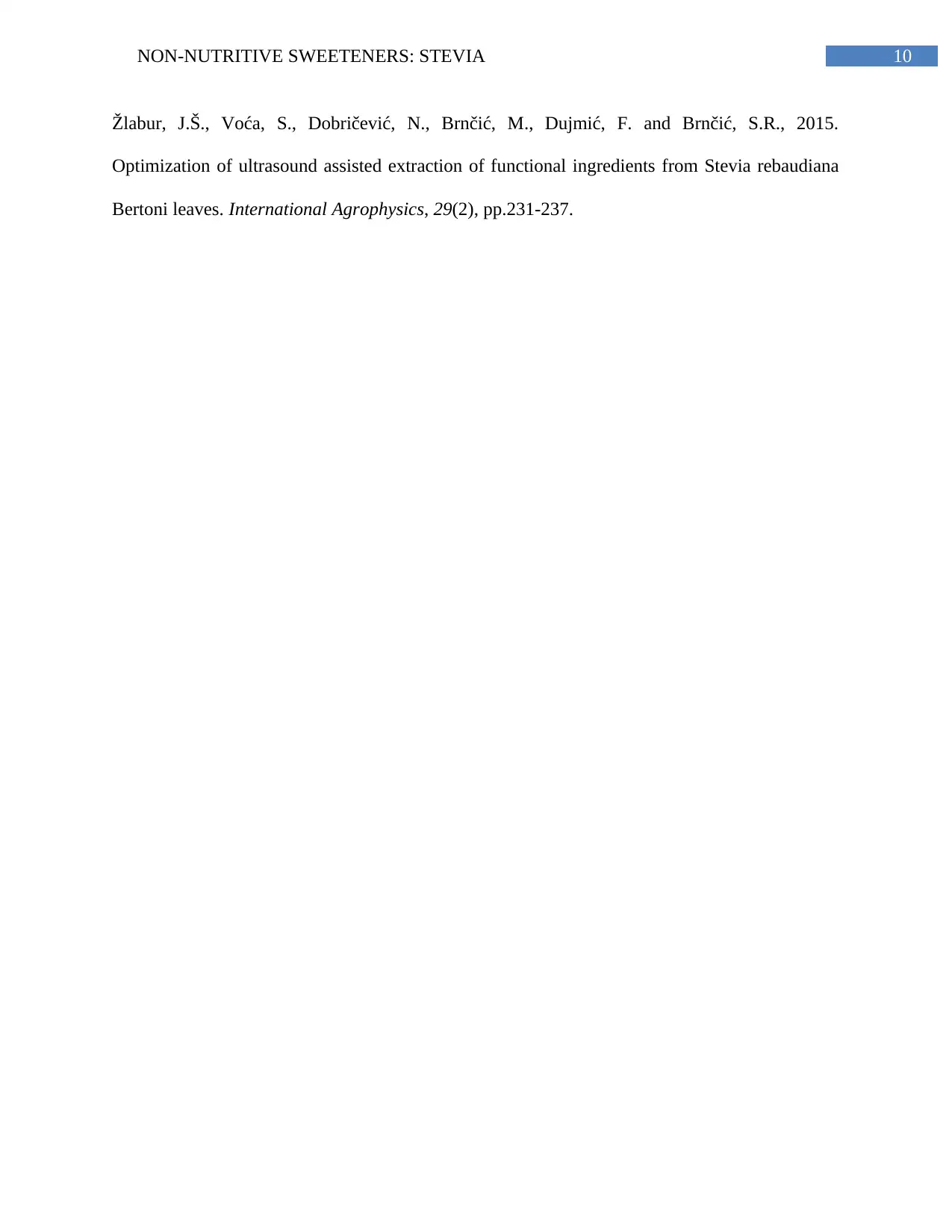
10NON-NUTRITIVE SWEETENERS: STEVIA
Žlabur, J.Š., Voća, S., Dobričević, N., Brnčić, M., Dujmić, F. and Brnčić, S.R., 2015.
Optimization of ultrasound assisted extraction of functional ingredients from Stevia rebaudiana
Bertoni leaves. International Agrophysics, 29(2), pp.231-237.
Žlabur, J.Š., Voća, S., Dobričević, N., Brnčić, M., Dujmić, F. and Brnčić, S.R., 2015.
Optimization of ultrasound assisted extraction of functional ingredients from Stevia rebaudiana
Bertoni leaves. International Agrophysics, 29(2), pp.231-237.
1 out of 11
Your All-in-One AI-Powered Toolkit for Academic Success.
+13062052269
info@desklib.com
Available 24*7 on WhatsApp / Email
![[object Object]](/_next/static/media/star-bottom.7253800d.svg)
Unlock your academic potential
Copyright © 2020–2025 A2Z Services. All Rights Reserved. Developed and managed by ZUCOL.